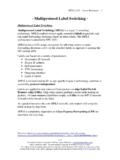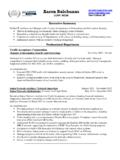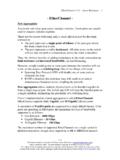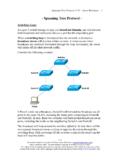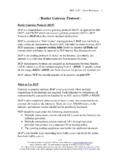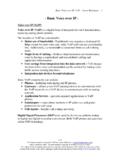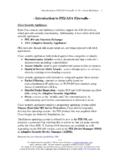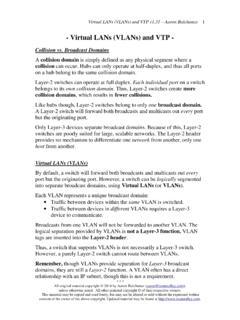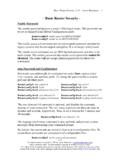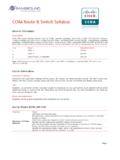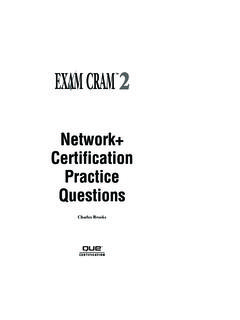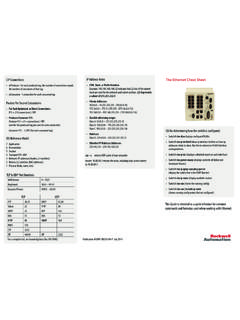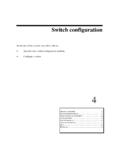Transcription of multicast - Router Alley
1 multicast Aaron Balchunas * * * All original material copyright 2007 by Aaron Balchunas unless otherwise noted. All other material copyright of their respective owners. This material may be copied and used freely, but may not be altered or sold without the expressed written consent of the owner of the above copyright. Updated material may be found at 1 - multicast - Types of packets Three types of packets can exist on an IPv4 network: Unicast A packet sent from one host to only one other host. A hub will forward a unicast out all ports. If a switch has a table entry for the unicast s MAC address, it will forward it out only the appropriate port.
2 Broadcast A packet sent from one host to all hosts on the IP subnet. Both hubs and switches will forward a broadcast out all ports. By definition, a Router will not forward a broadcast from one segment to another. multicast A packet sent from one host to a specific group of hosts. Switches, by default, will forward a multicast out all ports. A Router , by default, will not forward a multicast from one segment to another. multicast Concepts Remember, a multicast is a packet sent from one computer to a group of hosts. A host must join a multicast group in order to accept a multicast . Joining a multicast group can be accomplished statically or dynamically.
3 multicast traffic is generally sent from a multicast server, to multicast clients. Very rarely is a multicast packet sent back from a client to the server. Multicasts are utilized in a wide range of applications, most notably voice or video systems that have one source serving out data to a very specific group of clients. The key to configuring multicast is to ensure only the hosts that require the multicast traffic actually receive it. multicast Aaron Balchunas * * * All original material copyright 2007 by Aaron Balchunas unless otherwise noted. All other material copyright of their respective owners. This material may be copied and used freely, but may not be altered or sold without the expressed written consent of the owner of the above copyright.
4 Updated material may be found at 2 multicast Addressing IPv4 addresses are separated into several classes. Class A: Class B: Class C: Class D: Class D addresses have been reserved for multicast . Within the Class D address space, several ranges have been reserved for specific purposes: Reserved for routing and other network protocols, such as OSPF, RIP, VRRP, etc. Reserved for public use, can be used publicly on the Internet. Many addresses in this range have been reserved for specific applications Reserved for private use, and cannot be routed on the Internet. The following outlines several of the most common multicast addresses reserved for routing protocols: all hosts on this subnet all routers on this subnet all OSPF routers all OSPF Designated routers all RIPv2 routers all IGRP routers DHCP traffic all PIM routers ISIS routers IGMP traffic Cisco RP Announce Cisco RP Discovery multicast Aaron Balchunas * * * All original material copyright 2007 by Aaron Balchunas unless otherwise noted.
5 All other material copyright of their respective owners. This material may be copied and used freely, but may not be altered or sold without the expressed written consent of the owner of the above copyright. Updated material may be found at 3 multicast MAC Addresses Unfortunately, there is no ARP equivalent protocol for multicast addressing. Instead, a reserved range of MAC addresses were created for multicast IPs. All multicast MAC addresses begin with: Recall that the first six digits of a MAC address identify the vendor code, and the last 6 digits identify the specific host address. To complete the MAC address, the last 23 bits of the multicast IP address are used.
6 For example, consider the following multicast IP address and its binary equivalent: = Remember that a MAC address is 48 bits long, and that a multicast MAC must begin with In binary, that looks like: Add the last 23 bits of the multicast IP address to the MAC, and we get: That should be exactly 48 bits long. Converting that to Hex format, our full MAC address would be: How did I convert this to Hex? Remember that hexadecimal is Base 16 mathematics. Thus, to represent a single hexadecimal digit in binary, we would need 4 bits (24 = 16). So, we can break down the above binary MAC address into groups of four bits: Binary 0000 0001 0000 0000 0101 1110 0100 0001 1000 0010 1100 0011 Decimal 0 1 0 0 5 14 4 1 8 2 12 3 Hex 0 1 0 0 5 e 4 1 8 2 c 3 Hence the MAC address of multicast Aaron Balchunas * * * All original material copyright 2007 by Aaron Balchunas unless otherwise noted.
7 All other material copyright of their respective owners. This material may be copied and used freely, but may not be altered or sold without the expressed written consent of the owner of the above copyright. Updated material may be found at 4 multicast MAC Addresses (continued) Ready for some more math, you binary fiends? Calculate what the multicast MAC address would be for the following IP addresses: = = Remember that all multicast MACs begin with: = So, add the last 23 digits of each of the above IP addresses to the MAC address, and we get: = = In Hex, that would be: = = Wait a That s the exact same multicast MAC address, right?
8 Double-checking our math, we see that it s perfect. Believe it or not, each multicast MAC address can match 32 multicast IP addresses, because we re only taking the last 23 bits of our IP address. We already know that all multicast IP addresses MUST begin 1110. Looking at the address in binary: That leaves 5 bits in between our starting 1110, and the last 23 bits of our IP. Those 5 bits could be anything, and the multicast MAC address would be the same. Because 25 = 32, there are 32 multicast IP s per multicast MAC. According to the powers that be, the likelihood of two multicast systems utilizing the same multicast MAC is rare. The worst outcome would be that hosts joined to either multicast system would receive multicasts from both.
9 multicast Aaron Balchunas * * * All original material copyright 2007 by Aaron Balchunas unless otherwise noted. All other material copyright of their respective owners. This material may be copied and used freely, but may not be altered or sold without the expressed written consent of the owner of the above copyright. Updated material may be found at 5 Multicasts and Routing A Router , by default, will drop multicast traffic, unless a multicast routing protocol is utilized. multicast routing protocols ensure that data sent from a multicast source are received by (and only by) its corresponding multicast clients. Several multicast routing protocols exist, including: Protocol Independent multicast (PIM) multicast OSPF (MOSPF) Distance Vector multicast Routing Protocol (DVMRP) Core-Based Trees (CBT) multicast routing must be enabled globally on a Cisco Router or switch, before it can be used: Switch(config)# ip multicast -routing multicast Path Forwarding Normally, routers build routing tables that contain destination addresses, and route packets towards that destination.
10 With multicast , routers are concerned with routing packets away from the multicast source. This concept is called Reverse Path Forwarding (RPF). multicast routing protocols build tables that contain several elements: The multicast source, and its associated multicast address (labeled as S,G , or Source,Group ) Upstream interfaces that point towards the source Downstream interfaces that point away from the source towards multicast hosts. multicast Aaron Balchunas * * * All original material copyright 2007 by Aaron Balchunas unless otherwise noted. All other material copyright of their respective owners. This material may be copied and used freely, but may not be altered or sold without the expressed written consent of the owner of the above copyright.

